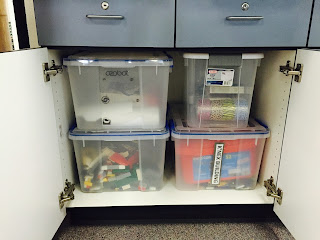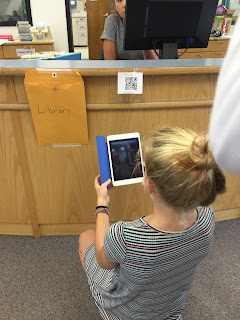First of All--a Shout Out to Jessica West!
Jessica West, who is part of the dynamic duo at Heatherwood Elementary's Library, was fulfilling her practicum hours at Centennial Middle School. The Maker Supplies were just crammed into a cabinet. She helped me inventory what we had, figure out how to maximize the space and also helped roll out the Maker Space to classroom visits. Thanks Jessica, I couldn't have done it without you!
Where Did You Get the Money?
I wrote and was awarded a National Educators Association Student Achievement Grant last year for $2,000 to start a Flexible/Mobile Maker Space. As part of the grant, I targeted students who were in academic support classes and therefore had less access to elective classes offered at the school. More on how this went in the next post. Click here for more info. about the grant.
Duct Tape Craft Kit
What have you Purchased and What Insights Did You Gain?
So far, I've spent roughly $1,150 of the grant and definitely learned some things along the way. Here are the kits I have set up so far and some insights on each:_____________________________________________________________________
Duct Tape Craft Kit

Duct Tape Craft Materials

15 Rolls Duct Tape
7 Scissors
2 Skill Scissors
1 Pen Knife
3 Measure Mats
5 Rules
6 Sharpies
Tape It & Make It Book ($15.00)
Approximate Cost: $90.00
Insights
Ah-Ha's/Things to Consider
One thing I am changing are the scissors I am using. I invested in Fiskar 5"Scissors for the smaller ones and they work much better than the other cheaper. batch scissors I ordered. The other scissors gum up and I have to clean them after each use, so I invested in more expensive Fiskor Scissors and am anxiously awaiting their arrival. The best way to clean scissors I've found is with rubbing alcohol and a sponge. Also, consider that duct tape is a consumable resource. Students love it because they make something and can take it home, but plan in your budget for more duct tape purchases. I started with six solid colored tape and a 12 roll variety of patterns, that I ordered on Amazon.
_______________________________________
OzoBot Kit
3 OzoBots
3 Sets of Markers
Random Ozobot Cards
3 Sets Small Plastic Bowling Pins (for Ozobot Challenge)
Approximate Cost: $180.00
Insights
Ozobots are programmable robots that use light sensors. You can draw and they can follow a pattern. Also, they can be programmed via a website with drag and drop code. The Ozoblockly website also has challenges and classrooms activities.
Things to Consider
I've found the Ozobots to be a a reasonably priced entry into Robotics for students. They can be glitchy at times and take a little practice to figure out. Also, they are tiny and easily could walk out of a makerspace, so I always "bird-dog" them when they are out. They do definitely have a Wow factor. One of the favorite activities is the magical eight ball where you ask the Ozobot a question, and then place it on the mat and it randomly ends up on a "yes", "no" or "maybe". I want to explore and learn more about Ozobot but am still learning.
K'Nex 70 Building Set
K'Nex 52 Building Set
4 Motors
Approximate Cost: $150.00
Insights
K'Nex are plastic hubs and rods that can be snapped together to make a number of different things. Students have made frisbees, cars, and air plane. I really liked adding the motors to provide power. The students have enjoyed this tub and often explore and self-explore. which I helpful for me if I'm working at a different station. Some students enjoyed making K'Nex vehicles and having a roller derby type race with them.
Lego Challenge Cards
Approximate Cost: Legos donated -- baseplates 4/$20.00
Insights
Kids love legos. Even middle school kids. Maybe it's the familiarity. Maybe it's the possibilities? Also, I was very lucky to have three large bins of legos donated to the library. I put out an all call to parents through an school e-blast and was able to get a generous donation. Kids love to build but also I printed up a series of lego challenge cards (link above) that students can then pick a card, and then complete the challenge. There's also a free Lego Movie Maker App you can load on i-pads and make movies, something I am excited to try it.
_________________________________________________________________________________
Little Bits Synth Kit
Approximate Cost: $150.00
Insights
I purchased a Little Bits Synth Kit with Bookfair Profits from Scholastic. Little bits are snap together circuits that are easy to configure. At first, I wasn't sure what to do with the kit, but then I just put it out there and let students experiment. The synth kit allows them to build different configurations to make different sounds. One student spent the entire hour trying out different parts and experimenting. Other students would wander over and he would show them what he figured out. I would call that Maker space Success!
Ah-ha
Although it's fun to let students experiment, if this was a classroom situation I would hook up the speak to headphones. I have a five to one headphone jack that would allow a group of students to listen to the sound. It's quite distracting otherwise.
_________________________________________________________________________________
Origami Robotics Kit
STORAGE
So we have set up storage using plastic tubs that are bar-coded if they leave the library. Jessica, Ziploc 44 Quart Tubs. These are perfect for fitting in the cabinets and also transferring the contents of tubs. We labelled the tubs and also bar-coded them so they can be checked out to teachers. They also fit neatly in the cabinets. I just ordered another set of smaller tubs--Sterilite 30 Quart-- to maximize storage space. Also, some of the kits do not require such a big tub such as the Origami Robotics or Ozo-Bots.
3 Sets of Markers
Random Ozobot Cards
3 Sets Small Plastic Bowling Pins (for Ozobot Challenge)
Approximate Cost: $180.00
Insights
Ozobots are programmable robots that use light sensors. You can draw and they can follow a pattern. Also, they can be programmed via a website with drag and drop code. The Ozoblockly website also has challenges and classrooms activities.
Things to Consider
I've found the Ozobots to be a a reasonably priced entry into Robotics for students. They can be glitchy at times and take a little practice to figure out. Also, they are tiny and easily could walk out of a makerspace, so I always "bird-dog" them when they are out. They do definitely have a Wow factor. One of the favorite activities is the magical eight ball where you ask the Ozobot a question, and then place it on the mat and it randomly ends up on a "yes", "no" or "maybe". I want to explore and learn more about Ozobot but am still learning.
_____________________________________________________________________
K'Nex Building Kit
K'Nex 52 Building Set
4 Motors
Approximate Cost: $150.00
Insights
K'Nex are plastic hubs and rods that can be snapped together to make a number of different things. Students have made frisbees, cars, and air plane. I really liked adding the motors to provide power. The students have enjoyed this tub and often explore and self-explore. which I helpful for me if I'm working at a different station. Some students enjoyed making K'Nex vehicles and having a roller derby type race with them.
Things to Consider
K'Nex have been around for awhile and there are some websites out there that offer different K'Nex Challenges. The K'Nex are reusable but not indestructible. I have had a few break on me. They also can be a little difficult to snap together or pull apart for smaller hands.
_________________________________________________________________________________
Lego Kits (3 total)
Various Legos (donated)
2-3 Lego Baseplates (10' by 10")Lego Challenge Cards
Approximate Cost: Legos donated -- baseplates 4/$20.00
Insights
Kids love legos. Even middle school kids. Maybe it's the familiarity. Maybe it's the possibilities? Also, I was very lucky to have three large bins of legos donated to the library. I put out an all call to parents through an school e-blast and was able to get a generous donation. Kids love to build but also I printed up a series of lego challenge cards (link above) that students can then pick a card, and then complete the challenge. There's also a free Lego Movie Maker App you can load on i-pads and make movies, something I am excited to try it.
_________________________________________________________________________________
Little Bits Synth Kit
Approximate Cost: $150.00
Insights
I purchased a Little Bits Synth Kit with Bookfair Profits from Scholastic. Little bits are snap together circuits that are easy to configure. At first, I wasn't sure what to do with the kit, but then I just put it out there and let students experiment. The synth kit allows them to build different configurations to make different sounds. One student spent the entire hour trying out different parts and experimenting. Other students would wander over and he would show them what he figured out. I would call that Maker space Success!
Ah-ha
Although it's fun to let students experiment, if this was a classroom situation I would hook up the speak to headphones. I have a five to one headphone jack that would allow a group of students to listen to the sound. It's quite distracting otherwise.
_________________________________________________________________________________
Origami Robotics Kit
- 26 Teknikio motor board
- 26 Teknikio battery board
- 50 batteries
- 100 LED lights
- 200 fasteners
- 2 rolls of conductive tape
- 1 roll electrical tape
- 280 sheets of origami paper
Insights
Honestly, I bought this kit as I was looking for a stand-alone/already set-up kit that I could easily roll out. I do like that this kit includes circuitry and motors and forces students to consider design-thinking when working with the materials. On a down side,it was fairly expensive ($300.00) and I believe you could cobble together a similar kit for far less. Teknikio sells the individual parts of the kit--and I'm sure you could find them elsewhere as well. Also, I wrestle with the fact that students will want to bring the supplies home, but at the same time, they can be resused. I'm still figuring out how to best utilize this kit.
_________________________________________________________________________________STORAGE
So we have set up storage using plastic tubs that are bar-coded if they leave the library. Jessica, Ziploc 44 Quart Tubs. These are perfect for fitting in the cabinets and also transferring the contents of tubs. We labelled the tubs and also bar-coded them so they can be checked out to teachers. They also fit neatly in the cabinets. I just ordered another set of smaller tubs--Sterilite 30 Quart-- to maximize storage space. Also, some of the kits do not require such a big tub such as the Origami Robotics or Ozo-Bots.













